User:LepidopteraMonarch/FinalDraft
Week 13 - Final Edit and Talk Page Summary - Formatting is unknown
[edit]
External Anatomy
[edit]- Head
- The head consists of the skull (formed from loosely connected bones), eyes, mouth, operculum, gills, and a pair of nostrils (which has no connection to the oral cavity). They have small brush-like teeth across their jaws and on the roof of their mouth. The gills are located under the operculum on both sides of the head and are used to extract oxygen molecules from water and expel carbon dioxide; the gills have gill rakers inside the mouth.[1]
- Sex Determination
- External anatomy can be used to determine the sex of Perch in multiple ways. Perch have two posterior openings located on their abdomen, the anal and urogenital. In males, the shape of the urogenital opening is round and larger than the anal opening. In females, the urogenital opening is often a V- or U-shape which is a similar size to the anal opening. Also, Males usually have a more brown-red colored urogenital opening compared to females. [2]
Internal Anatomy
[edit]The esophagus is a flexible tube that goes from the mouth to the stomach. The stomach is connected to the intestine via the pyloric sphincter.[1] The intestines of perch consist of the small intestine and large intestine; the intestines have many pyloric caeca and a spiral value, the small intestine consists of a part called the duodenum. The spleen is located after the stomach and before the spiral value. The spleen is connected to the circulatory system, not part of the digestive tract. The liver is composed of three lobes: one small lobe (includes the gall bladder) and two large lobes. Perch have long and narrow kidneys that contain clusters of nephrons which empty into the mesonephric duct. [3] They have a two-chambered heart consisting of four compartments: the sinus venous, one atrium, one ventricle, and conus.[4] Perch have a swim bladder that helps control buoyancy or floating within the water, the swim bladder is only found in bony fish. In perch, the duct connecting the swim bladder to the pharynx is closed so air is unable to pass through from the mouth, these fish are called physoclists. Specifically in perch, the gas bladder can vary from 12% to 25% of Oxygen and 1.4% to 2.9% of Carbon dioxide gas.[5] Perch reproductive organs include either a pair of testes (sperm-producing) or a pair of ovaries (egg-producing).[3]
- ^ a b Romer, Alfred Sherwood (1977). The vertebrate body. Thomas S. Parsons (5th ed.). Philadelphia: Saunders. ISBN 0-7216-7668-5. OCLC 3003870.
- ^ Shepherd, Brian S.; Rees, Christopher B.; Sepulveda‐Villet, Osvaldo J.; Palmquist, Debra E.; Binkowski, Fred P. (May 13, 2013). "Identification of Gender in Yellow Perch by External Morphology: Validation in Four Geographic Strains and Effects of Estradiol". North American Journal of Aquaculture. 75 (3): 361–372. doi:10.1080/15222055.2013.783520. ISSN 1522-2055.
- ^ a b Parker & Blair (2019). Origin and Evolution of Vertebrates. EDTECH. ISBN 978-1-83947-454-5. OCLC 1132388392.
- ^ Randall, D. J. (1968-05-01). "Functional Morphology of the Heart in Fishes". American Zoologist. 8 (2): 179–189. doi:10.1093/icb/8.2.179. ISSN 0003-1569.
- ^ B., Chiasson, Robert (1991). Laboratory anatomy of the perch. Wm. C. Brown. OCLC 640832481.
{{cite book}}: CS1 maint: multiple names: authors list (link)
